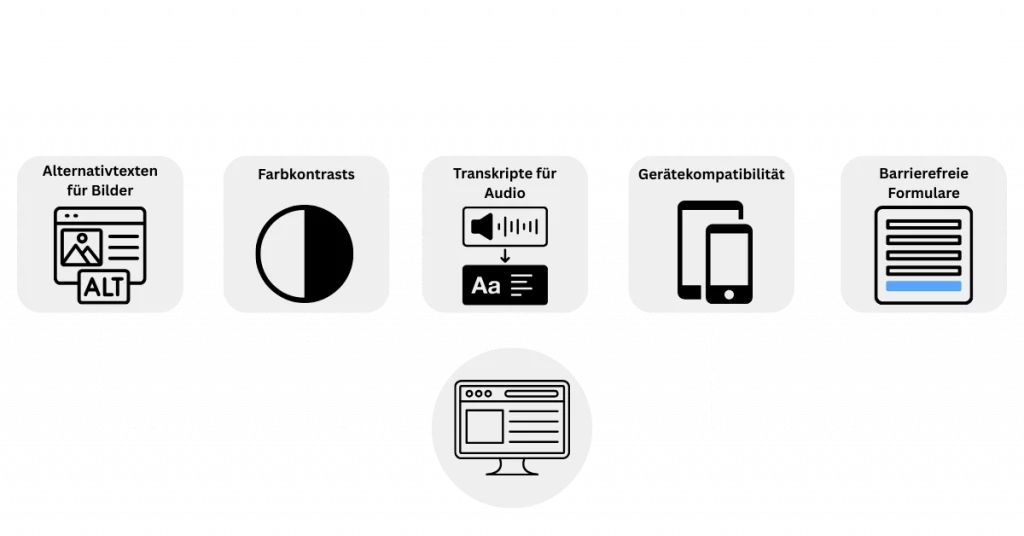Impacts of the Accessibility Act 2025 on Websites in the EU
- Webdesign
- July 18, 2025

Overview
The Accessibility Act is an EU-wide directive that will come into effect in June 2025 and aims to make digital products and services accessible to everyone – especially people with disabilities. Unlike the previous EU directive on web accessibility, the BFSG now also applies to private companies, particularly those offering digital services such as websites, apps, or e-commerce platforms.
In this blog, we examine the impact of the Accessibility Act on websites, explain which companies are affected, what requirements apply, and how businesses can prepare for implementation. The goal is not only to avoid legal risks but also to create a better, more inclusive user experience for all.
Table of Contents:
- What is the Accessibility Act 2025?
- What changes does this law bring?
- Who benefits from this law?
- Which companies must comply with the Accessibility Act 2025?
- How do the requirements affect websites?
- What companies should do now
- Is your website ready for the Accessibility Act?
- Frequently Asked Questions (FAQ) – Accessibility & Legal Compliance
What is the Accessibility Act 2025?
The Accessibility Act 2025 is an important EU directive aimed at making digital products and services more accessible for people with disabilities. It will come into full effect in June 2025 and extends accessibility requirements to private companies—not just public websites. Affected businesses include online shops, financial service providers, digital platforms, and mobile apps.
Small businesses with fewer than ten employees and an annual turnover or balance sheet total of no more than €2 million are partially exempt from some of the law's provisions.
What changes does this law bring?

Companies must redesign or adjust their websites to meet legally defined accessibility standards—particularly those outlined in WCAG 2.1 Level AA. The Accessibility Act results in:
- More inclusive digital environments
- Uniform legal requirements across all EU member states
- Penalties for non-compliance, such as fines or public suspension of services
These changes are intended to encourage businesses to see accessibility not merely as a legal obligation, but as a competitive advantage.
Is your website affected by this law?
If your website falls under the Accessibility Act, Synext IT will help you make it legally compliant – user-friendly, accessible, and future-proof.
Who benefits from this law?

This BFSG law primarily helps the following groups:
- People with visual impairments
- People with hearing impairments
- Individuals with motor or physical limitations
- People with cognitive disabilities
But the directive is also beneficial for:
- Older adults
- Individuals who use assistive technologies (e.g., screen readers, voice control)
- Users with temporary impairments (e.g., a broken arm, eye strain)
Accessibility benefits all users – not just those with permanent disabilities.
Which companies must comply with the Accessibility Act 2025?
All companies that offer digital services within the EU must comply with the requirements of the BFSG. This includes:
- Online shops and marketplaces
- Banks and financial service providers
- Telecommunications and media providers
- Transportation companies (e.g., booking systems)
- Streaming and educational platforms
Microenterprises (fewer than 10 employees or less than €2 million in annual turnover) may be exempt but are still encouraged to implement accessibility — for the sake of usability, social responsibility, and future-proof development.
Does the law also apply to B2B companies?
No — the Accessibility Act primarily targets B2C companies (business-to-consumer), meaning those that offer digital products or services directly to consumers. Pure B2B companies (business-to-business), which exclusively serve other businesses, are currently not required to comply with BFSG 2025. However, accessibility can also be beneficial in the B2B context — for example, for older users, accessible documentation, or public tenders.
How do the requirements affect websites?

In the future, websites will be required to meet specific digital accessibility standards, including:
- Providing alternative text for images
- Supporting keyboard navigation
- Using sufficient color contrast
- Providing subtitles and transcripts for audio and video content
- Structuring content with proper headings and labels
- Mobile Responsiveness und Gerätekompatibilitä
- Offering accessible forms and input fields that can be used with screen readers
Key Website Requirements According to the Accessibility Act
The BFSG defines specific requirements for websites and mobile applications:
Scope:
The BFSG applies to all digital platforms and applications within the EU – in both the public and private sectors. Only microenterprises are exempt.
Accessibility Requirements:
Websites must be usable by people with visual, auditory, motor, or cognitive impairments and must comply with the WCAG 2.1 AA guidelines.
Harmonization:
The goal is to establish a unified EU standard to reduce legal uncertainty and make compliance easier for businesses operating across borders.
Enforcement:
Each EU member state is responsible for monitoring and enforcement. This includes:
- Fines for violations
- Blocking of digital content or services
- Legal action up to product withdrawal from the market
How is the law monitored and enforced?
Each EU member state is responsible for monitoring and enforcing the law. In particular:
In Germany, each federal state will have a designated supervisory authority that regularly checks whether websites meet accessibility requirements. Initially, the focus will be on public websites, followed by increased monitoring of private providers.
Enforcement measures include:
Sanctions and fines
Public blocking of digital content
Legal action up to market withdrawal
What companies should do now
- Understand the law: Carefully review the BFSG and its national implementations
- Audit accessibility: Use tools like WAVE, axe, Lighthouse, and manual testing
- Implement changes: Integrate alt texts, subtitles, ARIA roles, and accessible forms
- Enable feedback: Provide users with accessible ways to report issues
- Document actions: Internally record and securely archive all steps taken
Key technical focus areas:
- Keyboard navigation: All functionality must be usable without a mouse
- Alternative text: Every image or icon must have a meaningful alt tag
- Captions & transcripts: Required for all video and audio content
- Clear link text: Avoid vague terms like "Click here"; use descriptive text like "Download PDF"
- Form labels: All fields must be labeled and accessible to screen readers
- Website structure: Use semantic HTML and correct heading hierarchies
Is your website ready for the Accessibility Act?

Ask yourself the following questions:
- Can your website be fully operated without a mouse?
- Do you use descriptive alt texts for all images?
- Are forms and buttons properly labeled and accessible?
- Does your site work reliably on mobile devices?
- Has your website been tested with a screen reader and keyboard?
If you hesitate to answer any of these questions, it’s time to take action. Acting early saves costs, stress, and legal risks later.
Synext IT Makes Your Website Accessible
At Synext IT, we specialize in developing fully accessible websites – in full compliance with the legal requirements of the Accessibility Act and the WCAG 2.1 AA standards.
Our services at a glance:
- Comprehensive accessibility audits including WCAG compliance checks
- Redesigns and adjustments for web and mobile devices
- Compatibility with screen readers and keyboard navigation
- Accessible forms, navigation, and content blocks
- Implementation of semantic HTML & structured data (Schema)
- Training and ongoing support for your team
Don’t wait for enforcement – make your website future-proof now.
Frequently Asked Questions (FAQ) – Accessibility & Legal Compliance
What is the main goal of the Accessibility Act?
The main goal of the Accessibility Act is to ensure that digital products and services are accessible to all users – especially people with disabilities. The BFSG promotes equal access to technology across the EU by establishing unified accessibility standards – particularly in areas such as websites, e-commerce, banking, and public services.
Does the Accessibility Act also apply to websites?
Yes. The Accessibility Act explicitly applies to websites and mobile applications of both public and private companies. Every provider of digital services – particularly in areas such as e-commerce, finance, or transportation – must ensure that their website complies with accessibility standards by June 2025, typically WCAG 2.1 Level AA.
How can I check my website for accessibility?
You can check your website using a combination of automated tools and manual testing:
- Use tools like WAVE, Lighthouse or axe DevTools
- Test your site using keyboard navigation (without a mouse)
- Use a screen reader such as NVDA or VoiceOver
Check color contrast, alt texts, heading structure, and form labels
- Evaluate mobile usability and responsiveness
For a complete evaluation, a professional accessibility audit is recommended.
Which standard currently applies to accessible websites?
The most widely adopted standard at present is WCAG 2.1 Level AA (Web Content Accessibility Guidelines), developed by the W3C Web Accessibility Initiative (WAI). These guidelines are also anchored in the BFSG and are based on four key principles:
- Perceivable
- Operable
- Understandable
- Robust
Can Synext IT help with implementing accessibility?
Yes! Synext IT specializes in the development and optimization of accessible websites in accordance with the requirements of the Accessibility Act. Our services include:
- Accessibility audits and technical reports
- Web design & development according to WCAG 2.1
- Accessible forms, navigation & menus
- Compatibility with screen readers & keyboard navigation
- Ongoing support, maintenance & monitoring
